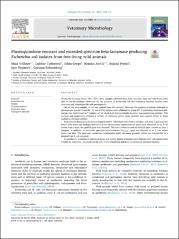Fluoroquinolone-resistant and extended-spectrum beta-lactamase producing Escherichia coli isolates from free-living wild animals

View/
Date
2018Author
Velhner, Maja
Todorović, Dalibor
Grego, Edita
Jovčić, Branko
Prunić, Bojana
Stojanov, Igor
Kehrenberg, Corinna
Metadata
Show full item recordAbstract
During the hunting season 2013–2014, fecal samples collected from hare, roe deer, deer and wild boars were
sent to the bacteriology laboratory for the isolation of Escherichia coli and multidrug resistant isolates were
characterized phenotypically and genotypically. Out of 106 fecal samples, E. coli was isolated from 101 samples. Although the majority of isolates belonged to phylogenetic groups A and B1, 14 out of 101 isolates were affiliated to group B2. A multidrug resistance phenotype was determined in 7 isolates, all of which had distinguishable genomic macrorestriction profiles. PCR
analysis and sequencing revealed a variety of resistance genes, gene cassettes and cassette arrays in these
multidrug resistant isolates. Resistance to fluoroquinolones was found in five E. coli isolates (two from a roe deer, one from a deer and two from a wild boar) and multiple mutations in the chromosomal topoisomerase genes were identified. In an E.coli
isolate from a hare, the qnrB19 gene was detected. The same isolate carried an aadA23 gene cassette in class 1
integron. In addition, an extended- spectrum beta-lactamase blaCTX-M-1 gene was detected in an E. coli isolate
from a roe deer. The gene was located on a conjugative multi resistance plasmid, which was transferable to a
plasmid free E. coli recipient. In conclusion, a number of resistance genes and mobile genetic elements were detected in E. coli isolates from wildlife in Vojvodina, emphasizing the role of environmental pollution in spreading resistant bacteria.
